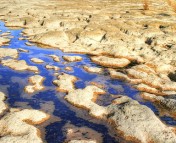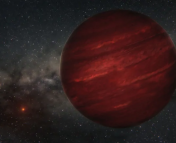Title: A mineralogical reason why all exoplanets cannot be equally oxidising
Authors: Claire Marie Guimond, Oliver Shorttle, Sean Jordan, John F. Rudge
First Author’s Institution: Department of Earth Sciences, University of Cambridge, Downing Street, Cambridge CB2 3EQ, UK
Status: Accepted to MNRAS [open access]
As exoplanet science advances, astronomy and geochemistry are drawn increasingly close together. One of the geochemical ideas now crossing into exoplanet science is oxygen fugacity (fO2), a parameter that measures the oxidation of a rock. Oxidation is important because it drives a lot of chemical reactions that determine a planet’s evolution, including the interior structure of the planet and the composition of the atmosphere.
Today’s authors use the elemental abundances of stars to constrain the possible range of oxidation states of exoplanets. They show that oxidation could produce observable differences in the outgassed atmospheres of exoplanets!
Typically, we measure oxidation by studying how iron in a rock is distributed between different oxidation states. For instance, a common approach is to compare the concentrations of pure iron metal versus iron oxides (iron bonded to oxygen in the rock). Planets aren’t static though, and as minerals in the rock react and change, so will the distribution of iron amongst different oxidation states. It’s pretty much impossible to know for sure the distribution of iron oxidation states in an exoplanet. However, because the mineral makeup of the planet pushes the fO2 away from its original value, the authors argue that we can understand the variation in oxidation that should be expected just based on the variations in composition. Different compositions will correspond to different possible mineral abundances, which in turn will determine the deviation in fO2 from the initial value during planet formation.
From stars to minerals
The sample of stars used in this study comes from the Hypatia Catalog, which includes thousands of stars of different types. Broadly, the relative amounts of more refractory elements in stars (such as Si, Mg, Fe) represent the material available for planet formation, and therefore the composition of any planets that would form in the system. So today’s authors take the abundances of elements in the Hypatia Catalog stars as representative of rocks that could form around nearby stars.
The authors are particularly interested in the oxidation at the tops of exoplanet mantles, since upper mantles are likely to melt into magmas and will eventually be responsible for outgassing various species into the planet’s atmosphere. To transform the stellar abundances into reasonable estimates for upper mantles, the authors remove a little bit of iron, which would end up in the planet core, as well as some of the more volatile elements. For each star, the authors then model different mineral reactions to figure out what mineral compositions are stable given the measured abundances of elements. In this process, they account for the cooling of the planet’s mantle until the material is solidified. Finally, they use the thermodynamic properties of the resulting stable mineral compositions to calculate the fO2.
In Figure 1, the authors show that the main driver of fO2 variation in the upper mantle is the ratio of Mg to Si in the rock (or star, in this case). The Mg/Si abundances directly determine the proportion of two main minerals, olivine and orthopyroxene, which heavily influence the distribution of iron. Despite fO2 depending on iron distributions, the overall amount of iron, based on the metallicity of the star, did not have a strong effect on the fO2.
Figure 1: You can think of the y axis as the relative fO2 calculated from the stellar abundances. We see here that fO2 is strongly correlated with Mg/Si abundances, but not as much with Al/Si or with the stellar metallicity [Fe/H]. Credit: Figure 4 from today’s paper
Atmospheric effects of fO2
fO2 has many effects, but the one that is most likely observable in the near future is the influence of fO2 on atmosphere composition. The magmas created by the upper mantle can contribute interesting gasses to the atmosphere, such as CO, CO2, water, and H2. As you might be able to guess, the relative amounts of those gasses are determined by fO2! Planets are complex systems, so fO2 doesn’t necessarily have the final say on atmosphere composition. Radiation from the host star and interactions between the atmosphere and other components of the planet will also influence different species in the atmosphere.
However, the authors show that fO2 could provide an extra bump to some species, making them a little easier to detect. Figure 2 shows the increases calculated relative to two standard reference oxidation states, as well as for an atmosphere that might result directly from the protoplanetary disk (left) and an atmosphere similar to Venus (right). The deviation from zero represents how much a variation in mineralogy, via fO2, could influence the abundances of these species. The effect is particularly strong for CO, SO2, and methane, all of which could be increased just beyond detection limits by fO2.
Figure 2: The y axis represents the mixing ratio for each species on the x axis (the abundance of that species relative to everything else), relative to what would be expected without the influence of mineral composition on fO2. The gray boxes show mixing ratios that are unlikely to be observable by atmosphere studies. Credit: Figure 7 from today’s paper
There’s still a lot to understand about the role of fO2 in exoplanets, and how the effects of oxidation mesh with other aspects of planet formation and evolution, but this study opens up exciting new ways to think about the chemistry of exoplanets!
Astrobite edited by: Kayla Kornoelje
Featured Image Credit: NASA/FUSE/Lynette Cook





AS a geology major and astronomy minor, I find this article refreshingly fascinating and engaging for its combination of the earth science and astronomy. I am not competent to review the suppositions, but I wish you the best in your efforts!
Sorry, NOT ‘open access’ at this date…
🙁